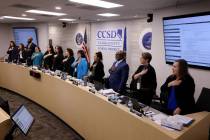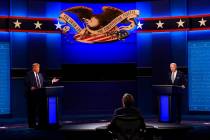Editorial: It’s a gas, gas, gas
An election nears, and what would a trip to the polls be without a ballot question seeking to separate taxpayers from their hard-earned cash?
On Tuesday, the Clark County Commission approved the wording for a November initiative designed to raise $3 billion — yes that’s a “b” — for local highway and road improvements by continuing to index a county fuel tax to inflation.
The fuel revenue index tax — in effect since 2013 and now at 10 cents a gallon — is assessed on top of the 52 cents a gallon levy Clark County motorists already pay when they feed their vehicles at the pump. If voters support extending the tax through 2026, the Regional Transportation Commission projects drivers will contribute an additional $3 billion as the levy steadily climbs to more than 46 cents a gallon over the next decade.
Putting aside whether this is a good deal for drivers and taxpayers, changing transportion habits could undermine some of the assumptions built into the ballot measure.
First, the tax isn’t actually tied to inflation, as many voters might define it. The U.S. inflation rate over the past 20 years has hovered in the 2 percent or 3 percent range — hitting just 0.1 percent last year — hardly enough to generate the kind of money county officials envision. Instead, they’ve hitched the tax to a rolling Producer Price Index based on road construction costs, which historically increase faster than other goods and services.
That’s why county revenue projections are based on a 4.54 percent annual inflation rate, far higher than the actual Consumer Price Index.
Second, many analysts foresee gasoline sales slipping in the near future, as electric vehicles gain a larger share of the automobile market. The Wall Street Journal reported this week that the energy consulting firm Wood Mackenzie projects that “electric cars are poised to reduce U.S. gasoline demand by 5 percent over the next two decades — and could cut it by as much as 20 percent.”
This might significantly undercut revenue estimates, as could the imposition of higher federal fuel-economy standards or a return to $4-a-gallon gasoline.
Another issue: The tax puts the onus for funding road improvements on those who own gasoline-powered vehicles, even though drivers of hybrids and electric cars also benefit from highway improvements and contribute to roadway wear and tear. Perhaps it’s time to create a special assessment for owners of these types of vehicles to reflect that reality and more fairly spread such costs.
As the region’s population has exploded over the past three decades, local voters have been amenable to paying higher taxes to fund road work, approving ambitious transportation ballot measures in both 1990 and 2002. But if they’re in a similar mood come November, they might not get all they’re being promised.























